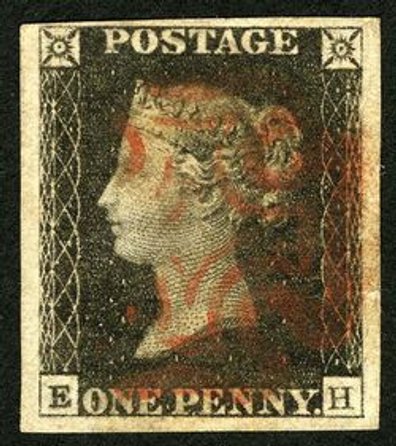With the adoption of the Penny Post on January 10, 1840 came the need to create a means to indicate prepayment of postage. Rowland Hill, appointed to the Treasury in 1839 to oversee the Penny Post transition, invented prepaid stationery and postage stamps. The Department of Treasury announced a competition, inviting “‘all artists, men of science, and the public in general’” as well as “’people in any part of the civilized world’” (Briggs 338) to submit designs for postage stamps and prepaid stationery, which took the form of letter sheets and envelopes. Public rejection of the stationery, called Mulreadies after designer William Mulready, was immediate and forceful; the design sparked caricature envelopes that essentially killed the Mulready, which was withdrawn from circulation in 1841. Hill believed the Victorians would prefer prepaid stationery and conceived of the postage stamp as an “after-thought” (Rigo de Righi 5); however, the stamp was an instant success. Perkins, Bacon & Petch, a government printer, worked day and night to keep up with the demand for postage stamps. The Victorians stood in lines to buy stamps, an innovation equal to today’s iPads and iPhones.



Left: A Mulready — Rowland Hill's prepaid stationery. Middle: Britannia Right: English colonists meeting Native Americans while in the foreground Africans work with large barrels (containing molasses or rum?). [Click on thumbnails for larger images]


Left and right: Scenes of English people reading letters apparebtly from those abroad. [Click on thumbnails for larger images]
The Mulready features Britannia atop a crouching lion overseeing a glorious postal outreach extending to all four corners of the globe; four winged angels (one missing a foot, a topic of much derision) bring news of Britain’s achievement to colonial possessions (e.g. India), former colonies (e.g. America), and places where England was currently fighting wars (e.g. China). Today we read in the Mulready design the geographical range of British political authority in 1840 that forecasts the increasingly aggressive expansion of British imperialism after the death of Prince Albert in 1861. The visual stereotypes of nation and race on the xenophobic top portion of the officially commissioned design — a pigtail for the Chinese, turbans for those from India and the middle East, a headdress for the Native American — remind us of the Nativist attitudes toward “un-English lands” that form a thorny part of Victorian nationality and pride. Sentimental scenes of hearth and home on the lower left and right sides idealize the Victorian family and illustrate how the Penny Post was intended to cheer the sick and infirm and keep Victorians connected in an increasingly mobile society.
The opposition to the design was due, in part, to a disjunction between form and function. There was not enough room for the address. Others objected to the allegorical-pictorial-historical design altogether. The caricature envelopes, which the public bought in droves, reveal widely held views of pressing mid-nineteenth-century concerns, prejudices, and preoccupations. Britannia was prime for caricature by leading caricaturists including John Leech and Hablot Knight Browne (better known as Phiz): she dons a jester’s cap, grows stouter and fatter, poses as a washerwoman, and becomes a pipe smoker. The lion wears a night cap, wears spectacles, bares its rump to the viewer, and turns into a menagerie of other animals including a donkey and a letter-reading poodle. Many caricatures make much of Mulready’s Irish origins (which he downplayed) and caricatured the Irish as well as the Chinese, an allusion to the First Opium War then raging in China.


Left: The Perkins D c.ylinder Printing Press on which the first stamps were produced Right: The Penny Black (also known as “Queen’s Head,&rdquo) — the first U. K. postage stamp. [Click on thumbnails for larger images]
In Post Office Reform, Hill describes his idea for a postage stamp as “a bit of paper just large enough to bear the stamp, and covered at the back with a glutinous wash” (45). Of the four prizes the Treasury awarded, Hill did not find any single entry suitable for stationery or stamps; nonetheless, he made use of several ideas, including William Wyon’s and Benjamin Cheverton’s concept of putting the sovereign’s head on the stamp. Cheverton (one of the prizewinners) also offered a persuasive argument for using a portrait: it would be difficult to forge. Likely influenced as well by the time-honored practice of putting a sovereign on the coinage, Hill commissioned Henry Corbould, a well-known illustrator and miniaturist, to make a drawing of Queen Victoria’s profile after William Wyon’s 1837 City Medal. The neoclassical design gracing the Penny Black is based on Wyon’s impressions of the young princess from a sitting when she was fifteen years old. The postage stamp became official on May 6, 1840. The stamp quickly became a model for other nations: in 1843, Brazil and the Swiss Cantons of Geneva and Zurich issued stamps, and the United States swiftly followed in 1847. The image of youthful Queen Victoria endures as the face of the Penny Black, which, in turn, became the model for all Victorian postage stamps and many colonial stamps.
Related Material
Bibliography
Briggs, Asa. Victorian Things. Chicago: University of Chicago Press, 1989.
Golden, Catherine. Posting It: The Victorian Revolution in Letter Writing. Gainesville, FL: University Press of Florida, 2009.
Hill, Rowland. Post Office Reform: Its Importance and Practicability. 2nd edition. London: Charles Knight, 1837.
Rigo de Righi, A. G. The Story of the Penny Black and its Contemporaries. London: National Postal Museum, 1980.
Last modified 8 July 2010